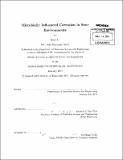Microbially influenced corrosion in sour environments
Author(s)
Li, Kwan (Kwan Hon)
DownloadFull printable version (13.17Mb)
Other Contributors
Massachusetts Institute of Technology. Department of Materials Science and Engineering.
Advisor
Krystyn̆ J. Van Vliet.
Terms of use
Metadata
Show full item recordAbstract
Microbially influenced corrosion (MIC) is a costly and poorly understood source of corrosion that plagues many modern industrial processes such as oil extraction and transportation. Throughout the years, many possible mechanisms for MIC have been proposed. One specific proposed mechanism was tested in this thesis: that the metal-binding characteristic of bacterial biofilms enhanced corrosion when it appears in conjunction with an iron sulfide film. Two model biogels were used: calcium alginate, which has this metal-binding property, and agarose, which does not. In pursuit of this hypothesis, iron sulfide films were grown on mild steel coupons. Two distinct forms of iron sulfides were grown: a loose black product at low sulfide concentrations, and an adherent gold product at high sulfide concentrations. Many materials characterization techniques were attempted, and the black corrosion product was found to be a mixture of greigite and marcasite. However, this composition was observed to change irreversibly with the application of a laser that caused the material to either heat and/or dry. The resulting golden-colored corrosion product was found to consist mainly of monosulfides, implying the presence of mackinawite or pyrrhotite. By using electrochemical polarization experiments, it was found that calcium alginate enhanced the rate of corrosion; agarose reduced the rate of corrosion. This is in contrast to previously published literature. Contrary to the initial hypothesis, adding an underlying iron sulfide film did not appreciably alter the measured rate of corrosion. Additionally, it was found that biofilms generated by sulfate-reducing bacteria (SRB) enhanced corrosion in a manner similar to the calcium alginate gel, and lysing the cells within the biofilm did nothing to alter this effect. This implies that the biofilm itself, even in the absence of active bacterial metabolic activity, can enhance corrosion rates observed in MIC.
Description
Thesis: S.M., Massachusetts Institute of Technology, Department of Materials Science and Engineering, 2014. Cataloged from PDF version of thesis. Includes bibliographical references (pages 119-123).
Date issued
2014Department
Massachusetts Institute of Technology. Department of Materials Science and EngineeringPublisher
Massachusetts Institute of Technology
Keywords
Materials Science and Engineering.